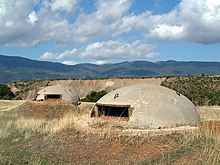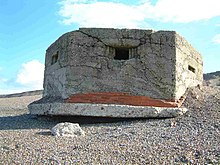Bunker
A military bunker is a hardened shelter, often buried partly or fully underground, designed to protect the inhabitants from falling bombs or other attacks. They were used extensively in World War I, World War II, and the Cold War for weapons facilities, command & control centers, and stores (e.g., for nuclear war).

| External images | |
|---|---|
| Atlantikwall UK pillboxes |
Types
Trench
This type of bunker is a small concrete structure, partly dug into the ground, which is usually a part of a trench system. Such bunkers give the defending soldiers better protection than the open trench and also include top protection against aerial attack (grenades, mortar shells). They also provide shelter against the weather.[2]
The front bunker of a trench system usually includes machine guns or mortars and forms a dominant shooting post. The rear bunkers are usually used as command posts or Tactical Operations Center (TOC), for storage and as field hospitals to attend to wounded soldiers.
Pillbox
Dug-in guard posts (with loopholes through which to fire guns) and made from concrete are also known as 'pillboxes'. The originally jocular name arose from their perceived similarity to the cylindrical boxes in which medical pills were once sold.[3] They are in effect a trench firing step hardened to protect against small-arms fire and grenades and raised to improve the field of fire.


Their use seems to have developed during the period of the First World War when defence in depth using the Machine Gun Corps was being perfected. However, most of those seen in Britain, having been left over from the 1940 invasion scare, are designed for use by riflemen rather than for machine gunners. The concrete nature of pillboxes means that they are a feature of prepared positions and their original use is likely to have been in the Hindenburg Line. This is likely to have been the time when they acquired their incongruous English name. The Oxford English Dictionary's earliest record of the use of the word pillbox in connection with a defensive post is from 13 September 1917, after the German withdrawal onto the Hindenburg Line.
Pillboxes are often camouflaged in order to conceal their location and to maximize the element of surprise. They may be part of a trench system, form an interlocking line of defence with other pillboxes by providing covering fire to each other (defence in depth), or they may be placed to guard strategic structures such as bridges and jetties.
Many pillboxes were built before WWII in the Czech Republic in defence against the German invasion of Czechoslovakia. None of these were actually used in the end, since the German military met no resistance when invading the country because it was effectively forced to capitulate as a result of Allies annexing the country's border areas and handing them to Germany. The Japanese also made use of pillboxes in their fortifications of Iwo Jima.
Artillery
Many artillery installations, especially for naval artillery have historically been protected by extensive bunker systems. These usually housed the crews serving the weapons, protected the ammunition against counter-battery fire, and in numerous examples also protected the guns themselves, though this was usually a trade-off reducing their fields of fire.
Since artillery bunkers were often constructed for very large guns in a pre-defined location and as part of a larger system of defenses (such as for a port town or a seacoast), they are amongst the largest individual pre-Cold War bunker types found. The walls of installations like the 'Batterie Todt' in northern France were up to 3.5 m thick, with the gun inside capable of reaching over the English Channel to the opposite coast.[4]
Industrial
Typical industrial bunkers include mining sites, food storage areas, dumps for materials, data storage, and sometimes living quarters. They were built mainly by nations like Germany during World War II to protect important industries from aerial bombardment. Industrial bunkers are also built for control rooms of dangerous activities, e.g. tests of rocket engines or explosive experiments. They are also built in order to perform dangerous experiments in them or to store radioactive or explosive goods. Such bunkers also exist on non-military facilities.
Personal
When a house is purpose-built with a bunker, the normal location is a reinforced below-grade bathroom with large cabinets. One common design approach uses fiber-reinforced plastic shells. Compressive protection may be provided by inexpensive earth arching. The overburden is designed to shield from radiation. To prevent the shelter from floating to the surface in high groundwater, some designs have a skirt held-down with the overburden.[5]
Design
Blast protection
Bunkers deflect the blast wave from nearby explosions to prevent ear and internal injuries to people sheltering in the bunker. While frame buildings collapse from as little as 3 psi (0.2 bar) of overpressure, bunkers are regularly constructed to survive several hundred psi (over 10 bar). This substantially decreases the likelihood that a bomb (other than a bunker buster) can harm the structure.
The basic plan is to provide a structure that is very strong in physical compression. The most common purpose-built structure is a buried, steel reinforced concrete vault or arch. Most expedient (makeshift) blast shelters are civil engineering structures that contain large buried tubes or pipes such as sewage or rapid transit tunnels. Improvised purpose-built blast shelters normally use earthen arches or vaults. To form these, a narrow (1-2 metre) flexible tent of thin wood is placed in a deep trench (usually the apex is below grade), and then covered with cloth or plastic, and then covered with 1-2 meters of tamped earth.
A large ground shock can move the walls of a bunker several centimeters in a few milliseconds. Bunkers designed for large ground shocks must have sprung internal buildings, hammocks, or bean-bag chairs to protect inhabitants from the walls and floors.
Nuclear protection
Nuclear bunkers must also cope with the underpressure that lasts for several seconds after the shock wave passes, and block radiation. Usually these features are easy to provide. The overburden (soil) and structure provide substantial radiation shielding, and the negative pressure is usually only 1/3 of the overpressure.

General features
The doors must be at least as strong as the walls. The usual design is a trap-door, to minimize the size and expense. To reduce the weight, the door is normally constructed of steel, with a fitted steel lintel and frame. Very thick wood also serves, and is more resistant to fire because it chars rather than melts. If the door is on the surface and will be exposed to the blast wave, the edge of the door is normally counter-sunk in the frame so that the blast wave or a reflection cannot lift the edge. A bunker should have two doors. Door shafts may double as ventilation shafts to reduce digging.
In bunkers inhabited for prolonged periods, large amounts of ventilation or air conditioning must be provided in order to prevent ill effects of heat. In bunkers designed for war-time use, manually-operated ventilators must be provided because supplies of electricity or gas are unreliable. One of the most efficient manual ventilator designs is the Kearny Air Pump. Ventilation openings in a bunker must be protected by blast valves. A blast valve is closed by a shock wave, but otherwise remains open. One form of expedient blast valve is tire-treads nailed or bolted to frames strong enough to resist the maximum overpressure.
If a bunker is in a built-up area, it may have to include water-cooling or an immersion tub and breathing tubes to protect inhabitants from fire storms.
Bunkers must also protect the inhabitants from normal weather, including rain, summer heat and winter cold. A normal form of rainproofing is to place plastic film on the bunker's main structure before burying it. Thick (5-mil or 0.13 mm), inexpensive polyethylene film serves quite well, because the overburden protects it from degradation by wind and sunlight.

Famous installations
Famous bunkers include the post-World War I Maginot Line on the French eastern border, World War II Führerbunker, the V-weapon installations in Germany (Mittelwerk) & France (e.g. La Coupole, and Le Blockhaus) and the Cold War installations in the United States (Cheyenne Mountain, Site R, and The Greenbrier), United Kingdom (Burlington), Canada (Diefenbunker), and Australia (Bankstown Bunker). The Soviet Union maintained huge bunkers (one of the secondary uses of the very deeply dug Moscow Subway system was as nuclear shelters), and in Albania, Enver Hoxha dotted the country with hundreds of thousands of bunkers. Osama bin Laden at one time was also rumoured to be hiding in massive 'underground fortresses' in Tora Bora, though these would only be natural features strengthened and extended to some degree.
References & Notes
- ^ Albania's Chemical Cache Raises Fears About Others - Washington Post, Monday 10 January 2005, Page A01
- ^ An archival look at World War I (from the Queen's University Archives, Kingston, Ontario, Canada. Accessed 2008-02-10.
- ^ Why Pillbox? - Hellis, John; an article from the Loopholes journal with further references. Retrieved 2007-09-08.
- ^ Accueil (from the Muse du Mur de l'Atlantique d'Audinghen website, in French. Accessed 2008-02-10.)
- ^ Kearny, Cresson H (1987). "Nuclear War Survival Skills" (html). Oak Ridge National Laboratory. ISBN 094248701X. Retrieved 2008-06-19. NOTE: Kearny recommends stockpiling materials for a blast or fallout shelter and constructing it only if war appears very likely.
